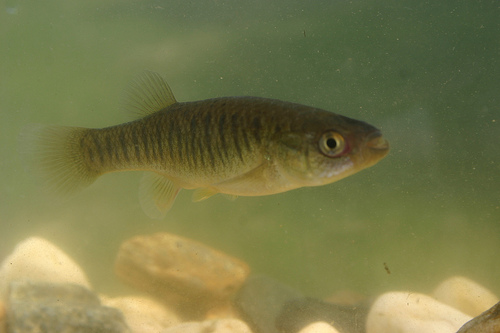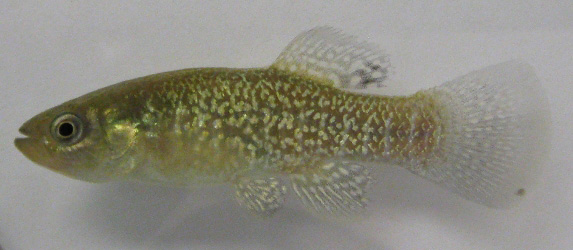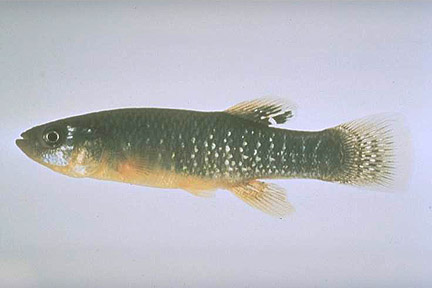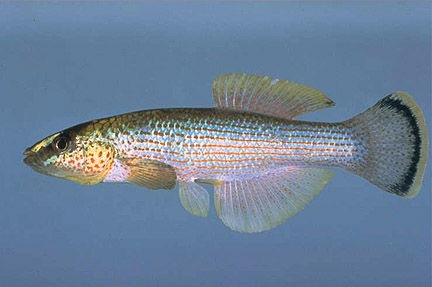
Fundulus heteroclitus macrolepidotus
FAMILY
Fundulidae
TAXONOMY
Fundulus heteroclitus macrolepidotus Walbaum, 1792, northern
America. In the 1980s, Able and Felley recognized the subspecies
status of the northern populations of Fundulus heteroclitus.
OTHER COMMON NAMES
English: Killie, killifish; Spanish: Fъndulo; Portuguese: Fundulo.
PHYSICAL CHARACTERISTICS
Grows to 5 in (13 cm) in length. Sexually dimorphic and dichromatic.
Males and females have up to 15 vertical bars, which tend
to be faint or missing in mature adults. The mouth is blunt,
with a turned-up lower jaw. The dorsal fin is positioned over the
anal fin origin at about the midbody. Males have a dorsal ocellus.
Breeding males are light gray to very black in background
color. The body and all unpaired fins have bright iridescent
white to greenish opalescent spots. The dorsal, anal, and caudal
fins have a yellow margin that is less noticeable on the caudal fin
in the black body variety. There is a yellowish cast to the abdomen
and operculum, the latter with iridescent silver highlights.
Color patterns and color intensities vary widely in both
sexes. Females are larger than males. Body is chunky with a pale
silvery background, brownish color on the back, and whitish
color on the abdomen. The fins are clear. Adults rarely are confused
with other species in their natural range.
DISTRIBUTION
From Chesapeake Bay, Maryland, United States, to Newfoundland,
Canada. Naturalized in the estuary of the
Guadalquivir River, southwestern Spain, and possibly established
in the salt marshes of the estuary of the Guadiana River,
at Castro Marim, southeastern Portugal.
HABITAT
The species is active primarily in tidally influenced coastal salt
marshes as well as estuaries, tidal streams and creeks, shallow
marine and brackish environments, and back-beach lagoons
reached by high tides. They have been reported for freshwater
portions of the Bronx River and naturalized in freshwater impoundments,
the latter likely due to bait-bucket releases. Most
studies of its habitats use have been undertaken in its primary
HABITAT
, the salt marshes.
BEHAVIOR
Traveling in huge schools numbering in the hundreds, the
mummichog is in constant search of food. As a result, fishers
find that they are caught easily in baited minnow traps. As a
predator on salt marsh invertebrates and small fish, and as a
prey item for wading birds and the blue crab, the northern
mummichog has a significant impact on salt marsh trophic dynamics.
The annual mortality rate is about 50% for adults and
more than 99% for the larval and juvenile class sizes.
FEEDING ECOLOGY AND DIET
Feeds on a variety of marine and freshwater invertebrates, diatoms,
mollusks, amphipods, crustaceans, plant material, insects,
detritus, worms, and small fishes. It is doubtful that a mummichog
would spurn anything edible that fits into its mouth. Mummichogs
are preyed upon by larger fish and fish-eating birds.
REPRODUCTIVE BIOLOGY
Judging by its reproductive
BEHAVIOR
in aquaria, the mummichog
probably spawns continually in the spring and summer,
but in nature its peak spawning activity is governed by a lunar
cycle. Eggs are laid in clumps on floating algae mats or at the
base of marsh grasses and buried in the sand in the high
marshes at the very high tides of the new moon or full moon.
The eggs are placed where desiccation will be minimized when
the tide goes out. The eggs hatch when they are immersed
again at the next very high tide. In aquaria water-incubated
eggs hatch in about 16 days.
CONSERVATION STATUS
Not listed by the IUCN.
SIGNIFICANCE TO HUMANS
The mummichog is used as a bait fish and as an aquarium animal;
it also is one of the most widely used laboratory animals.
It is a harmless species unless it is swallowed live. It has been
reported that many bored fishers have swallowed live mummichogs.
In one such instance, some of the fish were infected
with the larva of the nematode Eustrongyloides ignotus, causing
stomach and intestinal problems for three fishers, two of whom
required surgical intervention. Raasch noted, “Though 12 fishermen
reported no symptoms from this pastime, the moral is
that fishermen should abstain from taking the bait themselves
when the fish refuse to do so.”
Other popular Animals
Photo Gallery of - Northern mummichog





 Animalia Life
Animalia Life